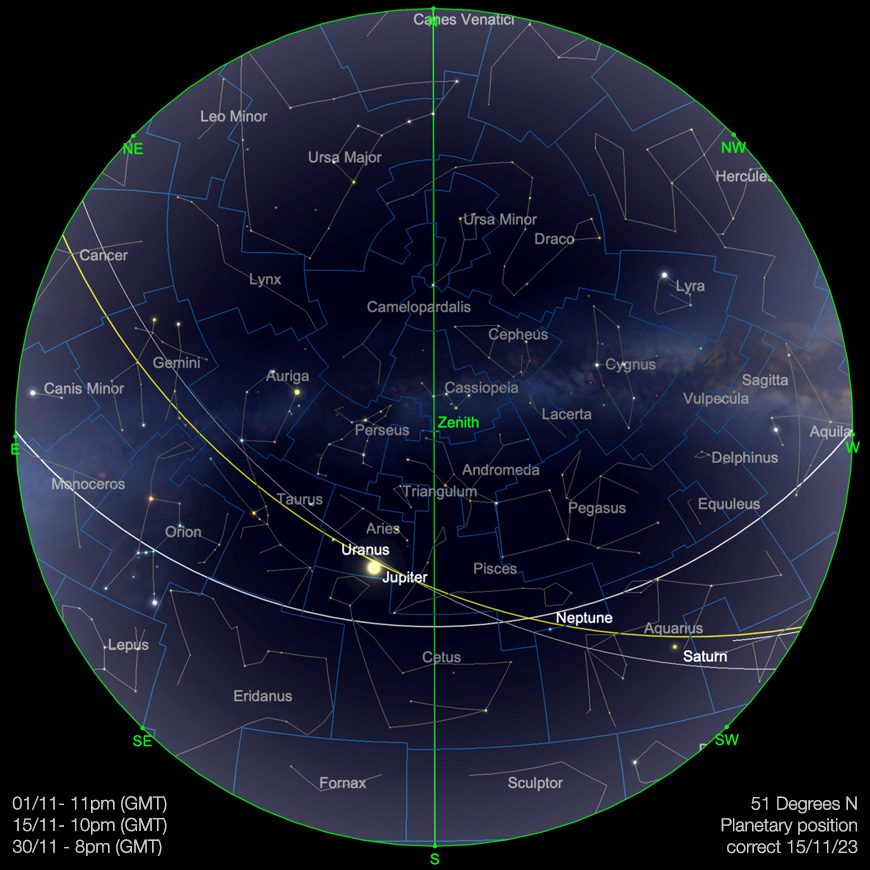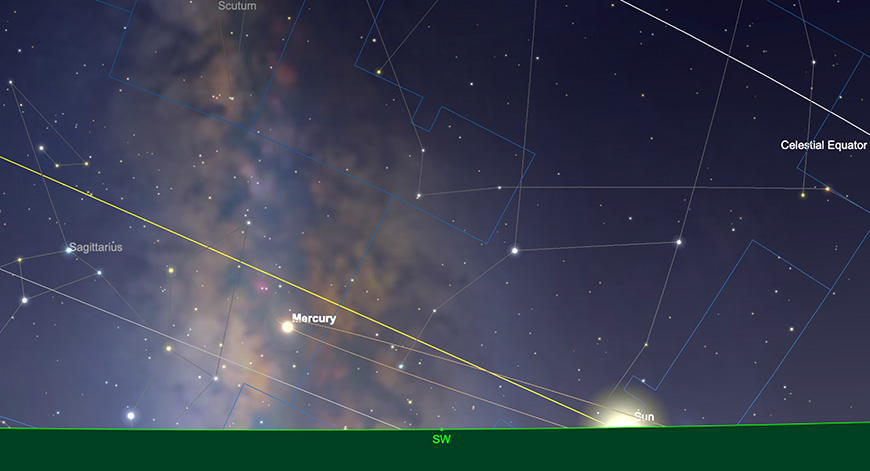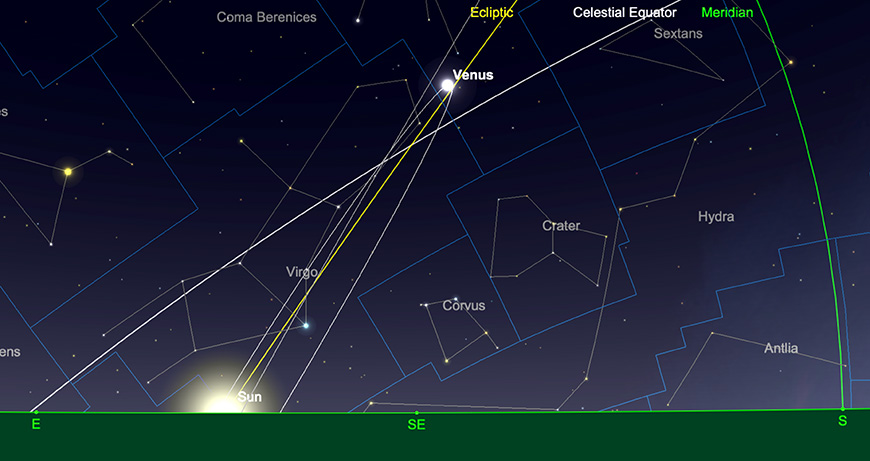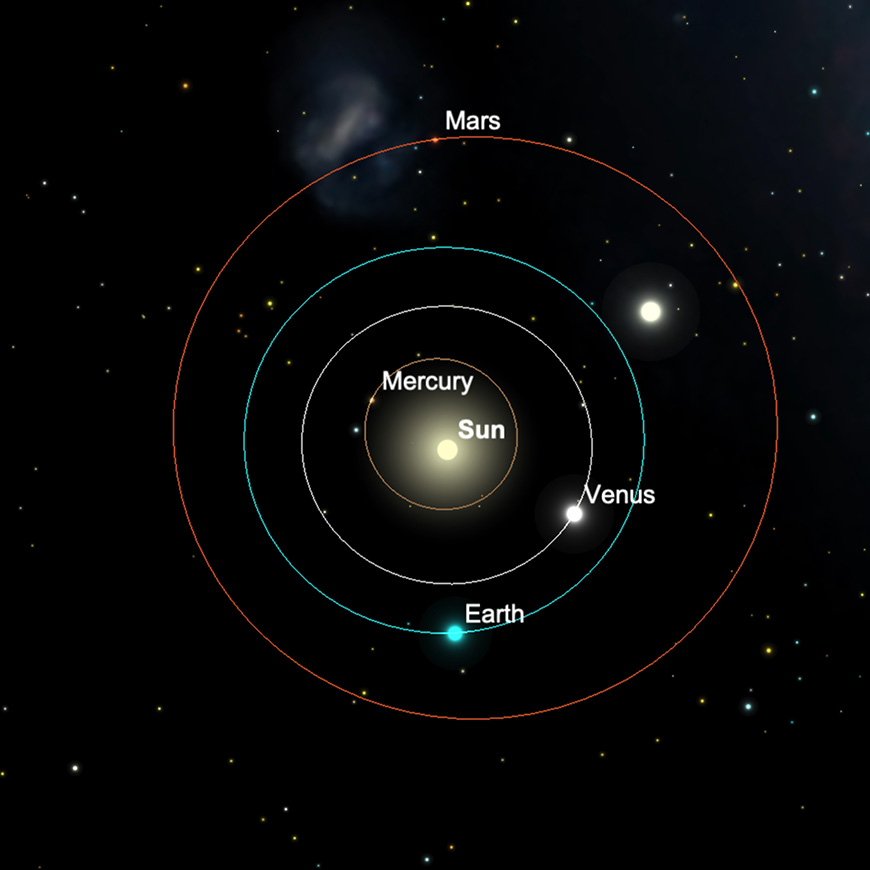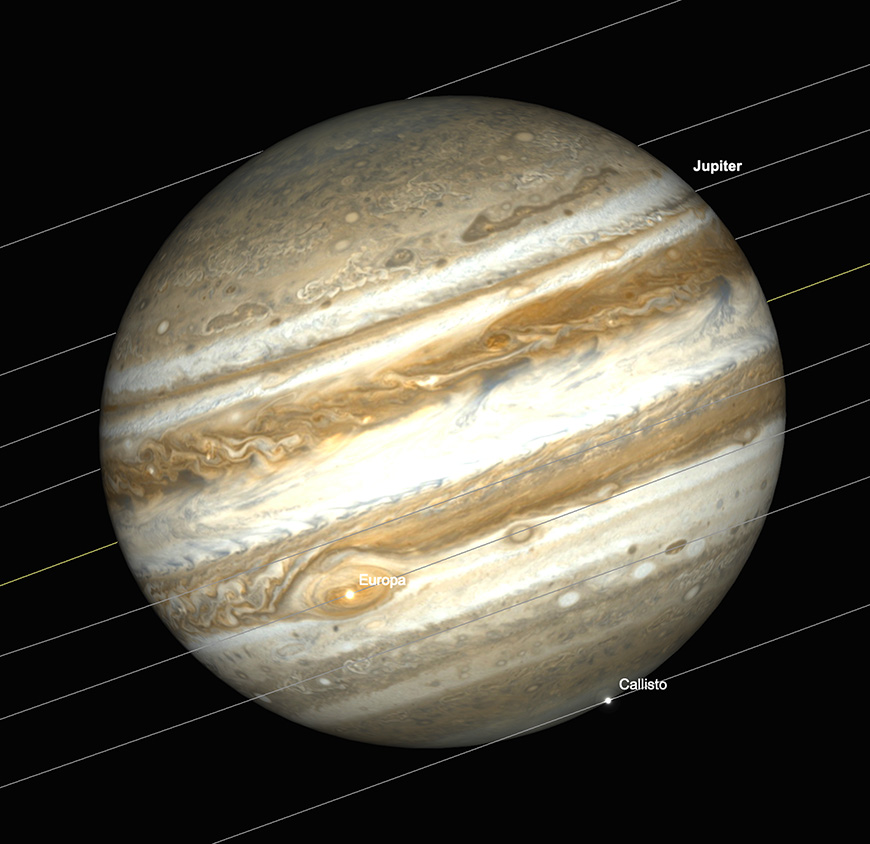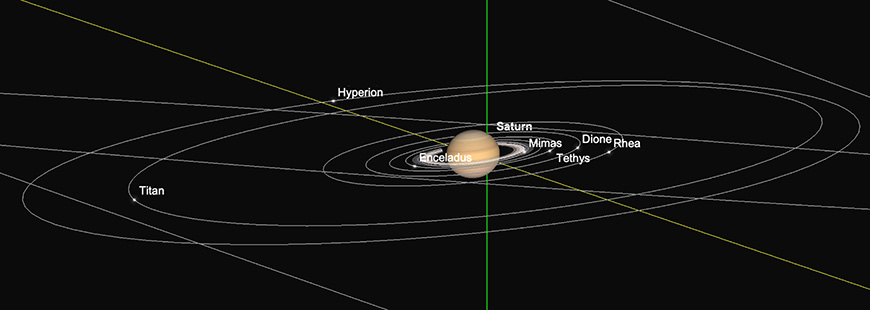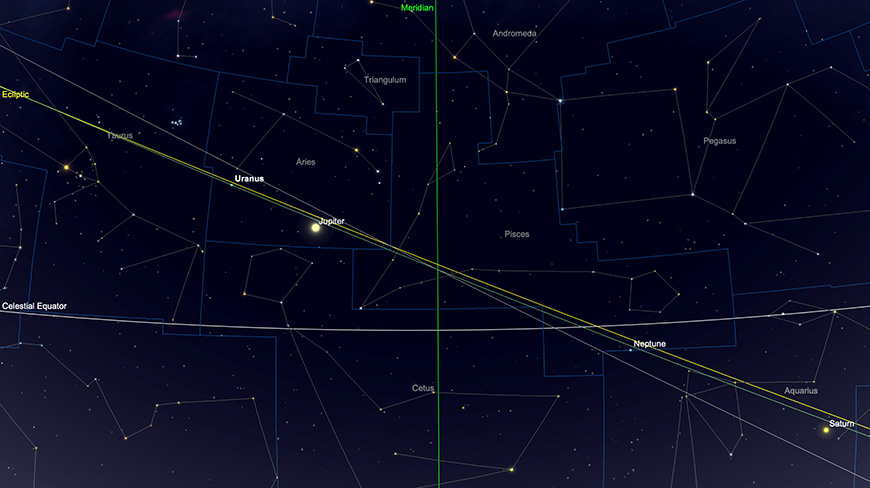Image created with SkySafari 5 for Mac OS X, ©2010-2016 Simulation Curriculum Corp., skysafariastronomy.com.
It's now November, and for those of us in the temperate northern hemisphere, the noticeable increase in darkness is hard to miss. With the conclusion of Summer Time in Europe and North America, astronomers in these regions will have the advantage of earlier opportunities for observation. Of course, the weather will inevitably play a significant role, as November tends to be cloudier and rainier, on average, compared to most other months, except for December and January in the northern hemisphere. However, as we approach the end of November, the drop in temperature often signals clearer skies. We all hold out hope for these conditions - as ever, there's plenty to see in the skies above us...
The Solar System
The Moon
After the excitement of late October’s partial lunar eclipse, November is a little more staid as far as the Moon is concerned.
Our natural satellite begins November at a Waning Gibbous phase, illuminated by 81%. Found on the borders between Taurus and Auriga, the Moon will rise a little before 7 pm (GMT), transiting as a just after 2.45 am the following morning on the 1st/2nd.
The next few days will see the moon crest over the most northerly part of the ecliptic, moving through Gemini, into Cancer, where it will reach Last Quarter on 5th. At this point in the month, the Moon will rise a little after 11 pm and transit after 6 am the following morning.
The next week in the run-up to new moon will see the moon displaying a very high crescent phase in the morning sky. This is the autumnal equivalent of the hHigh Spring Crescent phases of early springtime in the northern hemisphere and represents some of the best opportunities to view the moon from a northern hemisphere perspective - but only if you’re up early enough to do so. As the second week in November, commences, the Moon will gradually dip further and further towards the Sun, culminating in New Moon on November 13. At this point, the Moon will pass to the south of the Sun, while in the constellation of Libra. It is this part of the month that presents the best opportunities for deep sky viewing and imaging (weather permitting), with the Moon firmly out of the way during hours of darkness.
After New Moon, the moon will re-emerge as an evening target, but at this time of the year, it is very low in the sky, from a northern hemisphere observer’s perspective. As it will be passing through the southernmost part of the ecliptic, taking in the constellations of Scorpius, Ophiuchus, Sagittarius and Capricornus as it does.
The moon will reach First Quarter on November 20th when it will be found just 3 1/2° to the south of Saturn in the early evening sky. The moon will rise at just before 2 pm on the 20th, transiting at a little after 6.30 pm.
The latter part of November, or see the moon climb through the constellations of Aquarius on into Pisces and further north into Aries, where the moon and Jupiter will be found in close proximity to one another on the evening of November 25.
The Moon will come to Full on the night of November 27, when it will be found in the constellation of Taurus. At this point, the Moon will rise at a little before 4 pm and will be visible through the entire night. Naturally, this won’t be the best time of the month for deep sky observing and imaging. The last few days of the month sees the Moon cresting over the most northerly part of the ecliptic into Gemini, where we end of November with the Moon at Waxing Gibbous phase, displaying a 91% illumination.
Mercury
Mercury is technically an evening object at the beginning of November. However, it is nigh on impossible to observe from the temperate northern hemisphere, as it will only achieve an elevation of 1 1/2° above the horizon as the Sun sets on the 1st (as observed from 51° north). Mercury separated from the Sun by around 7° at the beginning of November and displays a -0.7 magnitude, 4.7 arc second diameter disc.
Mercury is moving away from the Sun as observed from Earth in early November, and by mid-month will have achieved separation of around 15° from our parent star. However, by this point, it is still pitifully low for many observers in the temperate northern hemisphere, attaining just 3° elevation above horizon when the Sun goes down (again, from 51° north). Mercury, on the evening of the 15th, is -0.4 magnitude and displays a 51 arc second disc, illuminated by around 91%.
And by the time we get to the end of November, things have improved very marginally as far as observation of mercury goes. The planet is still -0.4 magnitude, but is close to maximum eastern elongation and is now separated from the Sun by just under 21°. At sunset, Mercury will stand around five and three-quarter degrees high in the sky (again, as observed from 51° north). This is not a huge improvement, but may mean some observers with very clear, westerly horizons can hope to make some form of observation of the solar system’s innermost planet, by November’s end. It is worth pointing out that those in the equatorial and tropical regions of the Earth will have a fantastic view of Mercury by this point, standing proudly just under 21° high at sunset. When it comes to making observations of Mercury, at particular times, the position you find yourself on the Earth’s surface makes a huge difference to what you’ll see of this occasionally very elusive world.
Venus
Where Mercury is an evening target during November, Venus is exactly the opposite, spectacularly gracing the morning sky at just past maximum western elongation, which the planet achieved in late October. The morning of November 1st finds Venus separated from the Sun by just over 46°, standing around 36 1/2° above the horizon at sunrise, displaying a 55% illuminated disc of -4.3 magnitude brightness. Venus will be unmistakable to any observer, being so much brighter than anything else in morning sky.
As Venus has passed maximum elongation from the Sun, it will now gently head back towards a parent star, as observed from our perspective here on Earth. This is a much more gradual process than Mercury though, for good reason. Mercury’s year is just 88 days, as opposed to Venus, which takes 225 days to orbit the Sun.
By the time we reach mid month, not much has changed. Venus is still -4.3 magnitude, and stands just over 33 1/2° above the horizon at sunrise (from 51° north). It has decreased its separation from the Sun to 45°, but still remains a very easy and striking target in the morning sky.
By the time we get to the end of November, Venus will have decreased its brightness fractionally to -4.2 magnitude (though in reality won’t appear any fainter to the human eye). The planet will now stand around 29° high as the Sun rises. Dennis will now display a 17.2 arc second diameter disc. This is distinctly smaller diameter than that shown at the month’s beginning when it displayed a diameter of just over 22 arc seconds. The reason for this is fairly obvious – Venus is pulling away from the Earth on its faster interior orbit around the Sun and steadily decreasing in size as it recedes from us.
Venus will remain pretty well situated for morning observations until early 2024, but after the end of November, it starts to lose altitude as observed from the temperate northern hemisphere. As such, November really represents the last opportunity to see Venus over the “magic“ altitude of 30° above the horizon from higher northern latitudes. Once it drops below this altitude telescopic observers gradually have much more of the Earth’s atmosphere to contend with, which naturally detracts from observational clarity. If you’re up early enough, we thoroughly recommend checking out Venus at its best, while you can.
Mars
Mars finally reaches superior conjunction on November 18th, and as such will be invisible from Earth during the month. The planet will re-emerge as a morning target after this, but it will be a long time before Mars is back at its best, as the next Martian opposition will not occur until mid January 2025.
Jupiter
Where Mars is invisible, Jupiter is anything but. The planet reaches opposition on November 3, and will be unmistakable in the late evening sky at -2.9 magnitude, displaying a disc of just over 49 arc seconds. Owing to Jupiters size and relative position in the solar system, it is always a good target to observe telescopically from Earth (apart from the brief times every year when it is in close proximity to the Sun). This particular opposition, while not quite as great as 2022’s, is still an extremely favourable one, and everybody with a telescope is thoroughly encouraged to make the most of the solar system’s largest planet at its best.
Jupiter rises at a little before 4:45 pm in the evening in early November and transits just before midnight. We will have to wait until around eight in the evening (as observed 51° north) until the planet has reached 30° elevation above the horizon. After this point, Jupiter is in a much better area of the sky to observe, as it will be out of the way of the worst part of the truncation of Earth’s atmosphere, as seen from ground level. By the time Jupiter reaches transit point, it will be at an altitude of nearly 53° (again as observed from 51° North), and will be in a great area of the sky for observation. Being so bright, Jupiter is negatively affected by poor seeing conditions that much more noticeably than, for instance, its exterior neighbour, Saturn. As such, patience is the key to seeing Jupiter at its best position in the sky. Although it may mean staying up later to see Jupiter in a higher position in the sky, it will be well worth the wait.
By the time we get mid-November, not much has changed as far as Jupiter is concerned. The planet is still a visual magnitude of -2.9 and although it is shrunk fractionally to 49.1 seconds, this is still an extremely healthy size. By this point in time, Jupiter rise a little before 4 pm, transiting at just after 11 pm.
Fast forwarding to the end of the month, Jupiter, will have faded fractionally to a still brilliant -2.8 magnitude and now displays a 48 arc second diameter disc. In late November, Jupiter will rise at a little before 3 pm, transiting at just before 10 pm in the evening.
There are some worthwhile Jovian transit events that are visible from Europe, during November. The morning of November 4th, sees a mutual Great Red Spot and Europa transit starting at around 12:18 am. There is a brief mutual transit of Io and the Great Red Spot starting at 11:26 pm on November 13th. Or the following evening on November 14th, sees a mutual transit of Europa, Callisto (grazing Jupiter’s South Pole), and the Great Red Spot. This will be in full swing as Jupiter rises at in the early evening and will have finished in its entirety, by a little before 8 pm. November 17th, will see a brief mutual transit of Ganymede, and the great red spot which will have concluded by just after 11:30 pm. November 21 sees a mutual Europa and great red spot transit starting at a little before 6 pm. The morning of November 26st sees is a mutual great red spot and Ganymede transit starting at around midnight. The evening of the 29th sees a mutual Io and Great red spot transit starting at around 11 pm.
Saturn
Saturn is post-opposition and as such has faded a little from its brightest to +0.7 magnitude and displays a 17.8 arc second diameter disc on the evening of the 1st. The planet will rise at 2:45 in the afternoon at November’s beginning, transiting at a little before 7:45 pm. This puts Saturn in prime position for early evening observation during November. A resident of Aquarius, Saturn will not rise as high in the sky as its neighbour Jupiter does, but is still a respectable 26 1/2° above the horizon (as observed from 51° north) at transit on the 1st.
By the middle of November, Saturn has faded imperceivably to +0.8 magnitude, but still displays a healthy 17.4 arc second diameter disc. On the 15th it will rise a little before 2 pm and transit at just before 7 pm
Reaching November’s end and Saturn will be a little fainter still at +0.9 magnitude and will have shrunk very slightly to 16.9 of seconds diameter, the planet will rise at a little before 1 pm and transit at a little before 6 pm setting at just before 11 pm.
As mentioned in the previous sky guides, Saturn’s ring system is closing up from our perspective on Earth, and this has a slightly negative effect on the planet’s magnitude. However, this foreshortening of the ring plane also brings more of Saturn’s moons into a position where transits can be observed from Earth. The transits of Saturn’s moons are by no means as easy to detect in the telescope as those of the Galilean satellites, transmitting Jupiter’s disc. Jupiter is much larger. It is also closer to Earth and its major moons significantly bigger than many of Saturn’s innermost satellites. At present, Mimas, Tethys and Dione all intersect the Saturnian disc at transit point (the diminutive Enceladus does as well, good luck, witnessing one of these transits!). Those with reasonable aperture, telescopes, and steady sky conditions should, with patience, be able to detect at least some of the transit events of these moons. Next year, the moon prayer will also begin to transit sat on the desk and the year. After, 2025, when the Earth orbit across Saturn’s ring plane, all of the major satellites of Saturn, including the brightest and largest of the Saturnian moons, Titan, will cross Saturn’s disc. Although a ring plane crossing can be seen by some as being quite negative as far as observations go (with the full beauty of the rings somewhat diminished), the experience of seeing Saturn’s satellites lined up in front of the planet with the thin plane of the ring in full view, is really something to behold.
Uranus and Neptune
Uranus shares the constellation of Aries with the planet, Jupiter at present, so it will not surprise readers to find out that your news also comes to opposition this month as well, on the evening of November 13. At this point, Uranus will be +5.6 magnitude and display a 13.8 arc second diameter disc. As we frequently mention in sky guide, Uranus is technically a naked eye target, but requires a dark site and good observing skills to be able to find with the naked eye. It is a much easier proposition in binoculars and telescopes, and will reveal its small green grey disc once found. Jupiter's proximity to Uranus at present, will make it easier to find for many observers.
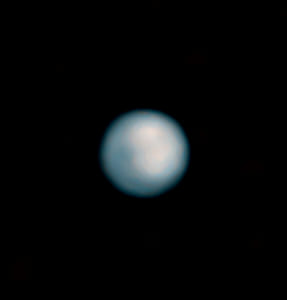
Uranus imaged by Bresser's Marco Hodde, September 2023, showing distinct albedo features. Taken with Vixen VMC 330L. Image used by kind permission.
Uranus was discovered in 1781 by the great astronomer William Herschel from his back garden in Bath. The planet has the merit of being the first major planet found with a telescope (all previous known naked eye planets being much more easily seen, unaided).
Herschel was somewhat bemused by his discovery, initially thinking it was a comet. However when analysis started to be made of the object’s orbit, it did not appear to be elongated like a comet’s, nor did it display any coma, nor tail. Yet it was clearly not a background star, though had been readily observed and identified as such, possibly as far back as Hipparchus’ stellar catalogue of the second century BCE. Further observations confirmed that what Herschel had discovered was indeed a new planetary member of our solar system. He was asked to name this planet by the astronomical community at the time and plumped for the snappy title Georgium Sidus (George’s Star), after his patron King George III. While this title may have gone down quite well in Britain, it was much less popular outside what was to become the United Kingdom. It would be another 70 years before Uranus finally was recognised as the object’s true name by the International astronomical community.
Uranus orbits the Sun once every 84 years, which means that in 2033 we will have been observing it telescopically for three of its orbits. It is only in powerful binoculars, or preferably a telescope, that we can see any suggestion of a disk, let alone any detail within it. Suitable magnification and conditions with the right telescope can reveal some banding of Uranus at times, though this is difficult to observe. The larger the aperture of your telescope, the better chance that you have of making such observations. At present, Uranus is presenting its north pole towards the Earth. Uranus is pretty unique within planetary standards in having a very pronounced orbital tilt. The planet is tilted over in respect to its orbital plane by nearly 98° – this is far more than any other planets in the solar system and could be a sign that Uranus has had a close encounter with a much larger body in the past, tipping it on its side.
Those with larger instruments in the 10+ inch aperture range may be able to find the brighter of Uranus‘s satellites, Oberon and Titania. These small moons will always be a challenge to observe, even for those with larger instruments, as they display a mean magnitude of around +13.7 to +14th magnitude. As for three fainter of the five largest moons - Ariel, Miranda and Umbriel - these can be detected in smaller telescopes, using cameras, which are more efficient than the human eye.
With Uranus riding relatively high in the northern ecliptic, now is a great time to make observations of this outer world. Although Uranus rarely gets fainter than +5.9 magnitude and can subsequently be observed through much of the year, rising at just before 5pm on the 1st of November and transiting at a little after midnight, makes it easy to track down at a reasonable hour of the night at present.
Neptune, now the last true “planet” in the outer solar system, can be found in Aquarius, further to the west. At +7.8 magnitude, Neptune can never be seen with the naked eye but is relatively easy to find in binoculars or small telescopes. Presenting a 2.3 arc second diameter disc, the planet is never particularly prominent, but once found displays a distinct bluish tinge, which is considerably more striking in hue than the grey-green disk colour that Uranus displays. Neptune transits at just before 8.30pm during mid-November and like Jupiter and Saturn should be sought out in the evening sky - though will be considerably more challenging to do so.

 English
English

